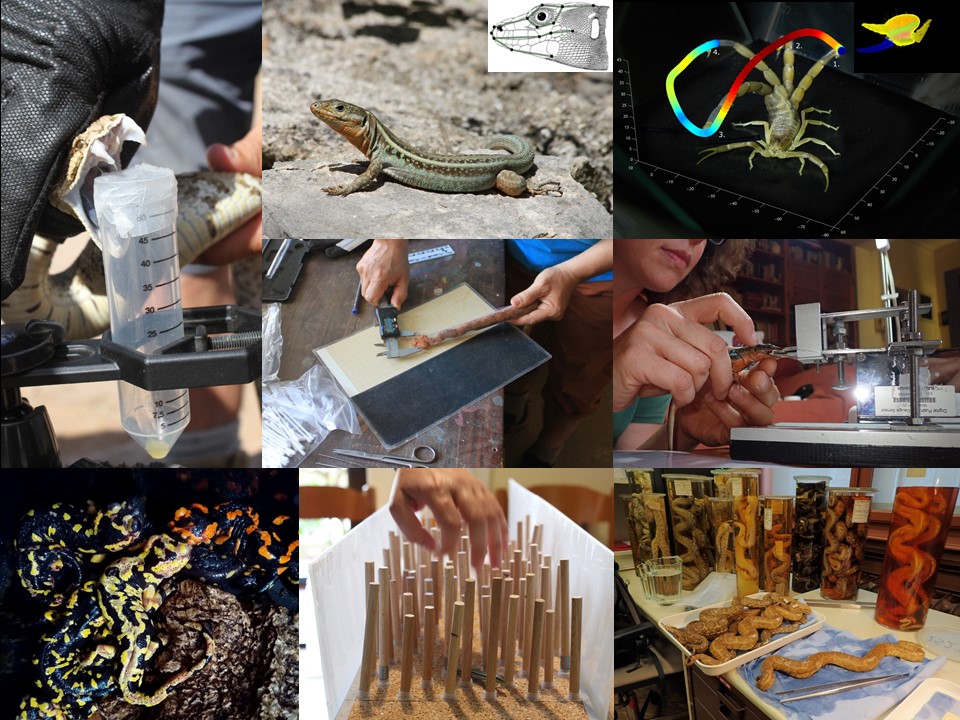Phenotypic Evolution - PHENEVOL
We aim at describing patterns, unveiling functions, and inferring processes related to the evolution of phenotypic diversity, to further contribute to biodiversity conservation. We use a variety of organisms as case study, mostly focusing on ectotherms like arachnids, amphibians, lizards and venomous snakes. We combine field data, laboratory experiments, and information obtained from museum collections and available online, and we use quantitative analytical approaches to test hypotheses about the mechanisms involved in shaping phenotypic patterns at the individual, population, species, and ecosystem levels. To fulfil this objective, we apply multidisciplinary approaches, using a variety of analytical tools, e.g. linear and geometric morphometrics, motion analysis, biomechanical modelling, ecological niche models, analyses of venom components (venomics), geostatistics and spatial analysis tools, phylogenetic, phylogeographic and population analyses, and phylogenetic comparative methods.

Through these methodologies, we dissect phenotypic evolution through a series of complementary research venues:
1 - DESCRIBING PHENOTYPIC VARIATION: We focus on several types of phenotypic traits, including (1) morphological traits as linear biometric body measurements with a potential functional significance, meristic and categorical traits with an evolutionary meaning and possible value for systematics, and organismal shape as quantified using geometric morphometrics; (2) ecological niche traits with both ecological and evolutionary meaning, describing the relation of organisms across the environment; and (3) components of snake venoms with a major ecological role in prey acquisition and predator defence. We address questions related to how phenotypes vary in geographic space, and across ecological gradients and evolutionary time, including e.g. ontogeny, sexual dimorphism, geographic and environmental gradients, and the evolutionary history of species and groups.
2 - FUNCTIONAL MEANING OF PHENOTYPIC VARIATION: To decipher how phenotypic variation translates into variation in fitness, providing the raw material for evolution through the action of selection, we focus on functional traits, using (1) biomechanics and functional morphology to link morphological traits to whole-organism performance and behaviour; and (2) eco-physiological modelling to understand relations of the organisms with their environment. Through laboratory experiments we quantify biomechanical traits related to locomotion, bite force, stinging performance, grasping and clinging capacity, and eco-physiological attributes as thermal preferences and metabolic rates. We then use multivariate statistical approaches to test hypotheses about how they are determined by phenotypic variation at the individual, population, and species levels. We also collaborate on bio-activity essays to investigate the biological function of the distinct components of snake venoms. All of this adds to our comprehension of the evolutionary potential of phenotypic variation.
3 - PROCESSES OF PHENOTYPIC EVOLUTION: To obtain a direct understanding of the mechanisms that drive phenotypic evolution, we test hypotheses about how phenotypic traits vary as a function of environmental and historical factors. Depending on the specific question at hand, we combine an ecomorphological or spatial statistics framework to analyse how structural and climatic variation influence morphological and functional traits (e.g. effects of environmental incubation temperature on sex and performance). To evaluate the influence of evolutionary history on the phenotype, we combine these analyses with data on population genetics and phylogenetics, and use a comparative framework, to investigate the tempo and mode of evolution at the intraspecific or macroevolutionary scales.
4 - APPLICATION TO CONSERVATION: To enhance biodiversity conservation under anthropogenic change, we integrate the previously gathered knowledge on patterns, functions and processes at distinct taxonomic and geographic levels. We rely on mechanistic approaches to establish causal relationships between, for instance, morphological, eco-physiological and behavioural traits and climatic variability to map species’ distributions and predict future species range dynamics and other potential evolutionary responses under climate change scenarios.
